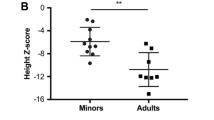Abstract
This overview covers the group of disorders that presents radiographically as multiple epiphyseal dysplasia (MED). The disorders include “classic MED” (Ribbing and Fairbank types): MED that is caused by mutations in the cartilage oligomeric matrix protein (COMP), type IX collagen, and matrilin 3 genes (MATN3); and MED with multilayered patella, brachydactyly, and clubbed feet resultant from mutations in gene defect diastrophic dysplasia (DTDST). The recently identified gene/molecular abnormalities in these disorders have made more exact identification possible in many cases, although clinical testing is not always available. However, there are specific radiographic findings that allow the accurate diagnosis to be made, thus potentially guiding which molecular defect(s) should be investigated. The modes of inheritance of these distinct MED conditions are not identical. When a specific diagnosis is made, proper genetic counseling as well as prognostication, management issues and complications can be delineated to the patient and family. This review will include the mechanics of diagnostic and molecular triage for these disorders.





Similar content being viewed by others
Notes
COMP analysis: cost, about $1800; turnaround time, 3–4 weeks
References
Lachman RS, Rimoin DL, Hollister DW (1973) Arthrography of the hip: a clue to the pathogenesis of the epiphyseal dysplasias. Radiology 108:317–322
Unger SL, Briggs MD, Holden, et al (2001) Multiple epiphyseal dysplasia: radiograpic abnormalities correlated with genotype. Pediatr Radiol 31:8–10
Mostert AK, Dijkstra PF, Jansen BR, et al (2003) Familial epiphyseal dysplasia due to matrilin-3 mutation: further delineation of the phenotype including 40 years follow-up. Am J Med Genet 120:490–497
Briggs MD, Chapman KL (2002) Pseudoachondroplasia and multiple epiphyseal dysplasia: mutation review, molecular interactions, and genotype to phenotype correlations. Hum Mutat 19:465–478
Unger S, Hecht JT (2001) Pseudoachondroplasia and multiple epiphyseal dysplasia: new etiologic developments. Am J Med Genet 106:244–260
Lachman R, Sillence D, Rimoin D, et al (1981) Diastrophic dysplasia: the death of a variant. Radiology 140:79–86
Makatie O, Savarirayan R, Bonafe L, et al (2003) Autosomal recessive multiple epiphyseal dysplasia with homozygosity for C653S in the DTDST gene: double-layer patella as a reliable sign. Am J Med Genet 122A:187–192
Rossi A, Superti-Furga A (2001) Mutations in the diastrophic dysplasia sulfate transporter (DTDST) gene (SLC26A2): 22 novel mutations, mutation review, associated skeletal phenotypes, and diagnostic relevance. Hum Genet 17:159–171
Superti-Furga A, Neumann L, Riebel T, et al (1999) Recessively inherited multiple epiphyseal dysplasia with normal stature, club foot, and double layered patella caused by a DTDST mutation. J Med Genet 36:621–624
Taybi H, Lachman RS (1996) Radiology of syndromes, metabolic disorders, and skeletal dysplasias, 4th edn. Mosby, St Louis, pp 869–870
Acknowledgements
The authors wish to thank Maryann Priore, Gina Rose, and Fiona Field for their help and management of the International Skeletal Dysplasia Registry.
Author information
Authors and Affiliations
Corresponding author
Additional information
This work was accomplished in part under NIH grant HD 22657.
Rights and permissions
About this article
Cite this article
Lachman, R.S., Krakow, D., Cohn, D.H. et al. MED, COMP, multilayered and NEIN: an overview of multiple epiphyseal dysplasia. Pediatr Radiol 35, 116–123 (2005). https://doi.org/10.1007/s00247-004-1323-4
Received:
Revised:
Accepted:
Published:
Issue Date:
DOI: https://doi.org/10.1007/s00247-004-1323-4




